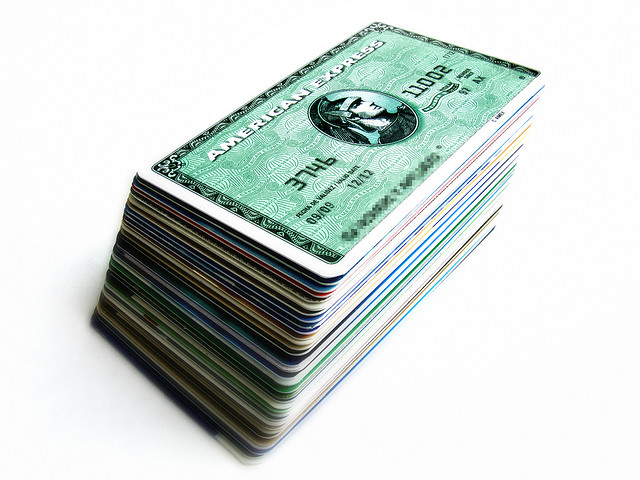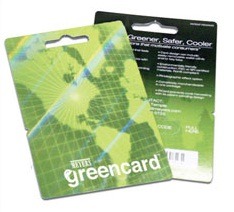You just received your new credit card, and have to destroy the old one. Good luck, the darned things are seemingly indestructible. Better have industrial-sized scissors. Too bad these are not recyclable; I just learned this after having dropped them in the recycling bin for years.
If you think about it, of course they aren't recyclable. After all, they have the magnetic strip and the hologram, neither of which are good for the environment. So how do we dispose of these little shoppers' best friends?
To find out, we talked with several of the leading credit card companies and the results are not so favorable. According to the International Card Manufacturers Association, over six billion cards are produced each year worldwide. That is enough to make over 50 stacks of cards higher than Mt. Everest, lest you think, "oh well, they are small and light, no harm done, put 'em in the landfill." Worst of all, they are made of a cheap but incredibly durable plastic called polyvinyl chloride, or PVC. This stuff contains a number of harmful chemicals and won't biodegrade for decades if not centuries. "PVC is forever;" the American Chemistry Council should adopt the diamond industry's slogan. PVC is considered in the top five chemicals that assault the environment by a number of experts.
 Stack of credit cards. Photo courtesy of Andres Rueda via Creative Commons.
Stack of credit cards. Photo courtesy of Andres Rueda via Creative Commons.
So what's a credit-loving environmentalist to do? Believe it or not, the only major issuer of credit cards to do anything substantive about this growing problem is Discover Card, which used to be part of Sears but is now an independent company. We spoke with Matthew Towson at Discover about their optional biodegradable card, which was launched in December 2008. "Our biodegradable card is made of a special type of PVC that will break down when exposed to landfill conditions," he said. "It will break down fully within five years." The only catch with this seemingly elegant solution is that if it gets wet (oops, I left it in my jeans pocket which is now in the washing machine) it will be ruined. That's why most other credit card companies won't offer it: they fear the possibility of frequent replacement costs for damaged cards.
"Alternatives to plastics are in the works," Towson explained. "Ultimately, consumers may no longer need an actual credit card. Discover has embraced mobile technology. Contactless stickers, while still plastic, are a lot smaller and can fit on the back of your cell phone." That would be convenient, but would also increase theft of cell phones significantly, I'd bet?
Surprisingly, American Express did not return our calls, and there is nothing on their website about sustainable cards. MasterCard's Jennifer Stalzer gave us boilerplate about the company's carbon footprint reduction but not a word about any plans to even address the plastic card issue. Visa fired us back an e-mail reply saying that "Visa cards are not recyclable as they are not solely made up of plastic. There are coatings placed on the card, a magnetic strip, some cards have chips, there is the issue of the Visa dove hologram, and therefore, they cannot be recycled." Not exactly the can-do entrepreneurial spirit for finding new solutions to environmental problems. Gail Hurdis of JP Morgan-Chase, the nation's largest issuer of debit cards, replied with, "I am not able to speak to the details of our plastics as it is proprietary information." Hmmm.
So what we have here is a problem that may seem trivial at first look but is actually one that needs to be solved. Surely if the automakers can create and build electric cars, 40 mpg+ hybrids and the like, the credit card industry can design itself a sustainable card?
There is a ray of hope here. A company called Meyers has developed the Greencard, a patented type of paper card with the look and feel of plastic. This unique card features a "tear strip" that can hold product identification codes, bar codes, magnetic strips and protected PIN codes. Decorative effects including holography and foil stamping are also available. Sounds perfect, yes?
 The Meyers Greencard.
The Meyers Greencard.
Well, even Meyers does not necessarily recommend the Greencard as a credit card replacement. They are marketing it as a shorter term, less durable but sustainable solution for gift cards, prepaid cards, music download cards, activation cards, phone cards and the like. Mark Dillon of Meyers confirmed that this innovation has been presented to the major credit card issuers, and they thought it was "an interesting product. However, it does not meet the durability and security requirements necessary for the three to five year credit card life cycle."
Think about this: the developing world and the billions of Chinese, Brazilians, Indians, Malaysians and more that are entering the middle class will all obtain credit cards relatively soon. This represents billions of dollars of growth for the credit card firms. One would think they could put together an industry association and fund the needed R&D to develop a sustainable card. Their objection so far has been cost? Come on, with the huge margins this industry earns, the least they could do to give back a little bit to the environment would be creating a special material-safe card. If small companies across the world are engaging in creating renewable energy solutions that could change the face of civilization over the next several years, surely there are a team of chemists that can concoct a material that is safe, recyclable and water resistant for making credit cards.